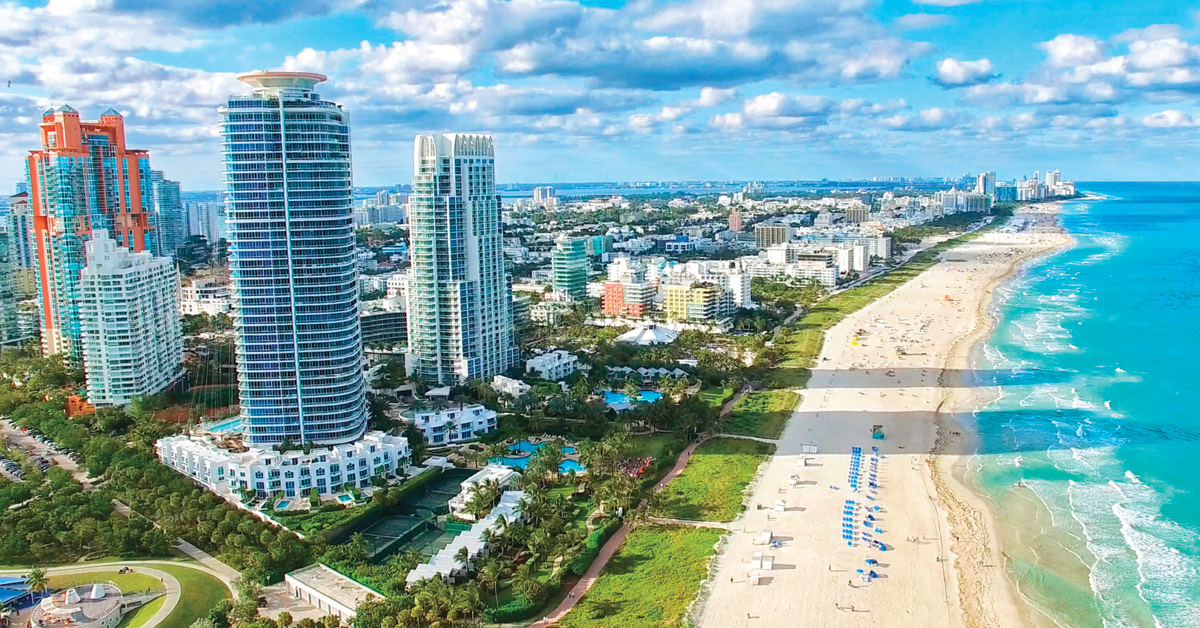Air conditioning made modern-day America. No better example of this exists than the state of Florida.
In 1950, Florida was not only one of the least populated Southern states, it was more sparsely populated than such states as Iowa, Minnesota and Indiana. There were about 1.9 million residents in Florida compared with 2.5 million in Iowa, 2.8 million in Minnesota and 3.4 million in Indiana.
Then, in the 1950s and ‘60s, air conditioners started becoming widespread in homes, offices and, just as importantly, cars. The share of the nation’s population in Sun Belt states, including Florida, grew from 28% in 1950 to 40% in 2000.
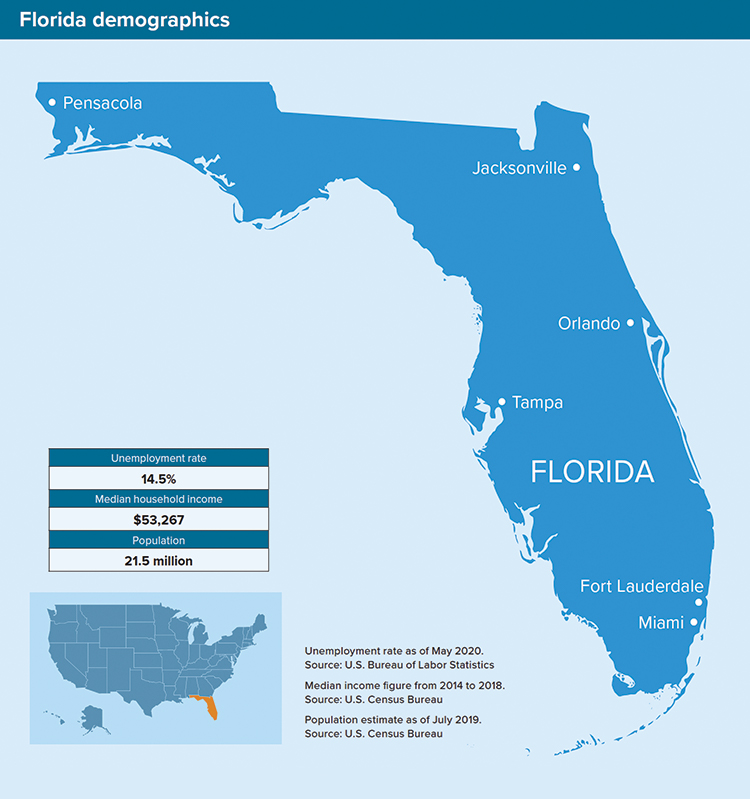 Florida’s population exploded. Today, more than 21 million people call the Sunshine State home, making it the third most-populous state behind California and Texas.
Florida’s population exploded. Today, more than 21 million people call the Sunshine State home, making it the third most-populous state behind California and Texas.
Florida also has become an economic powerhouse with an annual gross domestic product (GDP) — the sum of all goods and services produced in the state — of $883.1 billion. Florida ranks fourth in the U.S. in GDP with a strong mix of agriculture, health care and tourism.
In terms of agriculture, Florida ranks No. 1 in the country for its market value of oranges, grapefruits and other tropical foliage plants, according to the University of Florida. The state also is home to nine of the nation’s 25 largest beef producers. Beef is the state’s top international agricultural export.
Health care is big business in the Sunshine State as well. Florida’s 317 nonfederal hospitals accounted for $128 billion in economic output for the state economy in 2015, according to University of Florida economists. These hospitals employed more than 900,000 workers.
More than $1 out of every $10 produced in Florida is tied to tourism. Travelers are drawn to the state’s sprawling beaches, the cruise terminals in Miami and amusement parks around Orlando. Walt Disney World has the largest concentration of employees at one site of any single company in the U.S., with 70,000 workers at the park and auxiliary properties.
That’s why the coronavirus outbreak is so troubling for the state. Gov. Ron DeSantis pushed for businesses to reopen weeks after the COVID-19 pandemic struck. But late this past June, Florida saw a spike in coronavirus cases, with more than 100,000 people infected, a number that is rising.
Climate change is a serious concern for the Sunshine State. Sea levels are expected to rise eight to 12 inches along the coast by 2040, according to the nonprofit Resources for the Future. Storms are expected to become more severe, with 100-year floods occurring every few years. Left unchecked, flooding could endanger more than 300,000 Florida homes. •
Florida Home Sales
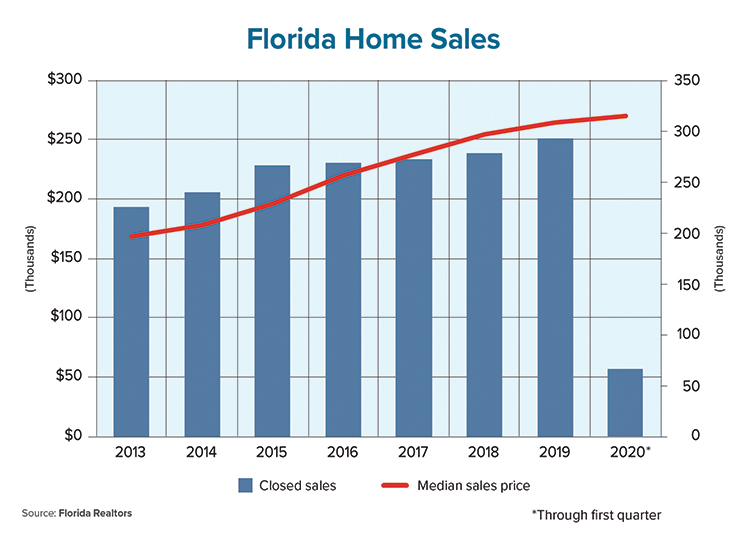 The coronavirus outbreak was a splash of cold water on Florida real estate. Closed sales for single-family homes fell annually by 36.2% in April 2020, while closed sales for condominiums and townhouses fell 50.3%, according to Florida Realtors.
The coronavirus outbreak was a splash of cold water on Florida real estate. Closed sales for single-family homes fell annually by 36.2% in April 2020, while closed sales for condominiums and townhouses fell 50.3%, according to Florida Realtors.
The Sunshine State rebounded this past May as single-family sales were up 2.3% year over year, although condos and townhouses were down 16.8%. At that time, however, the pandemic hadn’t impacted home prices. The state had seen 101 consecutive months of home-price gains, including a median sales price of $270,000 for single-family homes in May, up 1.5% year over year. Condos and townhouses went up by 3.3% annually to $201,472.
Florida’s real estate market relies heavily on foreign buyers. Between August 2018 and July 2019, international buyers purchased $16 billion worth of residential properties in Florida, or 12% of the overall market during that time, according to Florida Realtors. That, however, was a 30% decrease from the prior 12 months when foreign-based sales reached $22.9 billion.
Focus: Space Industry
Space begins — and Earth’s atmosphere ends — 62 miles above sea level at what’s called the Kármán line, named after a Hungarian physicist. The line blurs, however, over the distinctions between the aerospace and space industries. Aerospace is a major industry in Florida with more than 17,000 companies, 130,000 employees and $19 billion in annual revenues.
The space industry has had its own unique history in Florida ever since Alan Shepard became the first American to enter space, launching in 1961 from Cape Canaveral. NASA maintains a large presence in the state with more than 11,000 employees alone at the Kennedy Space Center.
Private industry is taking on a more central role in the exploration of space. SpaceX launched astronauts Doug Hurley and Bob Behnken into space from Cape Canaveral this past spring, the first Americans launched into space from U.S. soil since 2011.
What the locals say
“I actually really thought, when (the coronavirus outbreak) happened, ‘You know what? I can go back to being a normal person for a little while. Maybe I’ll be able to work 50 hours a week.’ And boy, was I wrong. I mean, literally I’m here and I started at like 7:30 in the morning. I leave here at 9, 10 o’clock at night, and then I’m home working till 1 in the morning. That’s how crazy it is. … We can’t even keep up. We’re hiring more staff. People are working overtime. So, there’s never been a lull here in Florida. You cannot keep homes on the market. It’s back to a seller’s market.”
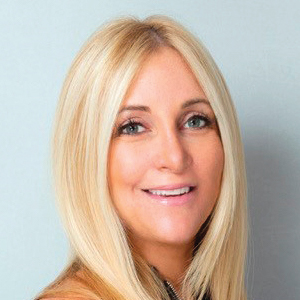
Lauren Maxwell
Executive vice president, CrossCountry Mortgage
3 Cities to Watch
Miami
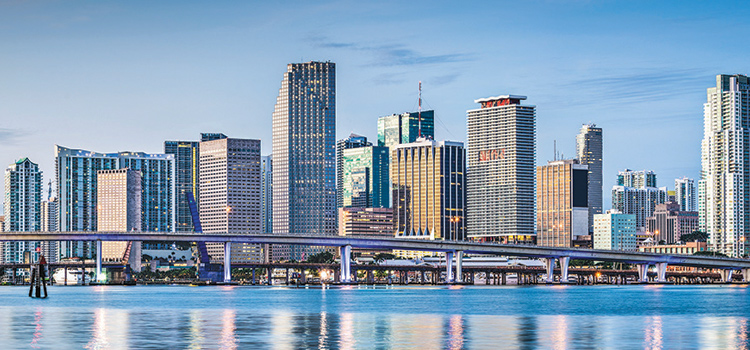 For such a celebrated city, Miami has been around for a relatively short amount of time. The city wasn’t incorporated until 1896 when only 444 people lived there. Miami grew fast, leading to the rise in the 1920s and ‘30s of the now famous Art Deco District.. Today, more than 2.7 million people live in Miami-Dade County. The city’s largest private, non-health care employers are American Airlines (11,000 employees), Carnival Cruise Lines (3,500) and Royal Caribbean International/Celebrity Cruises (3,000).
For such a celebrated city, Miami has been around for a relatively short amount of time. The city wasn’t incorporated until 1896 when only 444 people lived there. Miami grew fast, leading to the rise in the 1920s and ‘30s of the now famous Art Deco District.. Today, more than 2.7 million people live in Miami-Dade County. The city’s largest private, non-health care employers are American Airlines (11,000 employees), Carnival Cruise Lines (3,500) and Royal Caribbean International/Celebrity Cruises (3,000).
Orlando
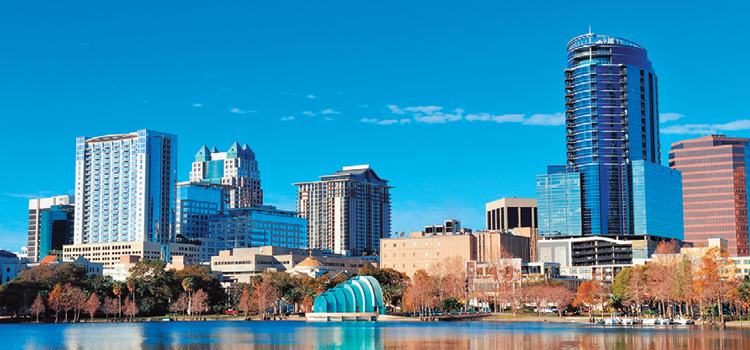 No one is quite sure how Orlando got its name. There are several competing stories, including how a prominent judge who was a Shakespeare buff named the city after a character in “As You Like It.” Incorporated in 1875, Orlando grew into a major agricultural area, but Disney World’s opening in 1971 changed the focus of the economy from agriculture to tourism. About 2.5 million people live in the Greater Orlando area. Walmart is one of the largest private employers in the area with 13,000 workers.
No one is quite sure how Orlando got its name. There are several competing stories, including how a prominent judge who was a Shakespeare buff named the city after a character in “As You Like It.” Incorporated in 1875, Orlando grew into a major agricultural area, but Disney World’s opening in 1971 changed the focus of the economy from agriculture to tourism. About 2.5 million people live in the Greater Orlando area. Walmart is one of the largest private employers in the area with 13,000 workers.
Jacksonville
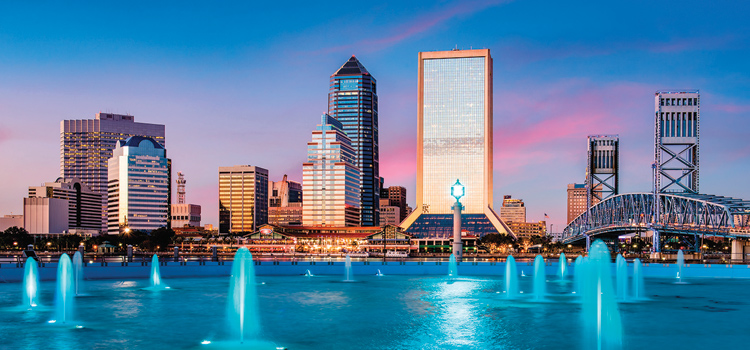 The largest city in Florida by population is Jacksonville with more than 911,000 residents, although its corresponding metro area of 1.5 million is smaller than other Florida metros. The city was named for future president Andrew Jackson, who was once the state’s provisional governor. Jacksonville is growing at twice the rate of the rest of the nation. The U.S. Navy is one of the largest employers in the community with some 21,000 employees at Naval Air Station Jacksonville and another 12,000-plus at Naval Station Mayport.
The largest city in Florida by population is Jacksonville with more than 911,000 residents, although its corresponding metro area of 1.5 million is smaller than other Florida metros. The city was named for future president Andrew Jackson, who was once the state’s provisional governor. Jacksonville is growing at twice the rate of the rest of the nation. The U.S. Navy is one of the largest employers in the community with some 21,000 employees at Naval Air Station Jacksonville and another 12,000-plus at Naval Station Mayport.
Sources: Business Insider; CoreLogic; Enterprise Florida; Florida Back Roads Travel; Florida Department of State; Florida Realtors; Fortune; Greater Miami Convention & Visitors Bureau; Jacksonville Daily Record; Miami-Dade Beacon Council; Naples Daily News; NASA; National Geographic; Orlando Business Journal; Space Florida; Tallahassee Democrat; The Atlantic; University of Central Florida; University of Florida; USA Today; U.S. Bureau of Labor Statistics; U.S. Census Bureau; Visit Jacksonville

